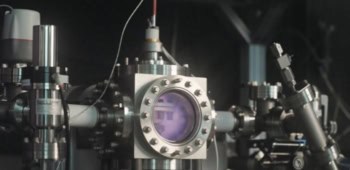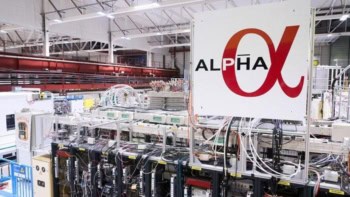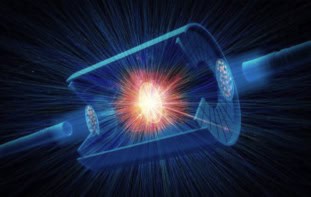Andrew Holland, chief executive of the Fusion Industry Association, tells Hamish Johnston how commercial fusion could be delivering electricity to the grid by 2035

What is the Fusion Industry Association (FIA)?
The FIA is the independent business association for privately financed fusion-energy companies. We have 38 members, all of whom have different approaches to reaching commercial fusion energy.
How do you become a member?
You need to have raised private capital and demonstrate a plan for building a fusion power plant that will sell the power it generates. All of the FIA companies think that they can get there within the coming decades and have investors who believe it is possible.
Why fusion?
Fusion energy is clean, safe, sustainable, always on and always available with a fuel source that is virtually unlimited. By unlimited I mean that we have hundreds of millions or even billions of years of fuel here on Earth. Fusion creates no carbon emissions, no greenhouse-gas emissions and has no long-lived nuclear waste. There’s also no threat of having a nuclear meltdown so there is no safety impact to the public. It’s basically everything you could want from an energy source.
So why don’t we have it already?
It is scientifically very hard to do. We’re still at the point where we need to do a lot of engineering and still some science to get there. The challenge is not just to create fusion, but to create fusion with net energy – to get more energy out of the fusion reaction than you put in. But we believe we’re on the way to doing this and we believe the signposts are there that show we’re not in the realm of science fiction. In a decade or so we can have commercial fusion energy, putting clean, safe, sustainable fusion energy into the grid.
What other applications are there?
One is to use fusion to generate medical isotopes, which can be very helpful for certain forms of cancer treatment or in medical imaging. These are things that are happening right now. Another is fusion propulsion for space applications, which could mean getting from low-Earth orbit to Mars in a matter of weeks or a month instead of years. But the real “killer app” is energy production. We need alternative approaches and fusion is the ultimate energy source. What we need to meet the climate challenge is to have always on, always available, zero-carbon energy.
What are some of the ways to generate fusion?
On one end is laser inertial fusion energy. This involves using a laser or other driver to put a lot of energy onto a very small target, creating an extreme pressure situation where fusion happens. At the other end of plasma physics is magnetically confined fusion, using powerful magnets to contain the plasma in a steady state, which also takes a lot of energy.
And laser fusion has seen some recent success?
Yes, last year physicists and engineers at the laser-based National Ignition Facility in California reported an energy gain in one of their fusion shots. We really see this as a Wright brothers moment. The Wright brothers understood that planes would fly and it took a whole new area of science – aeronautical engineering – to be able to do this. Likewise, we think we’re there with fusion and the plane has flown. We’re not selling it yet, but we’re on our way.

What do you think of other large-scale experiments, such as ITER, which is currently being built in Cadarache, France, and has been beset by delays and cost hikes?
ITER is being built with a very different need or approach than that of private approaches to fusion. ITER is, of course, an essential science experiment and an important example of how countries can work together. ITER was put together as low risk in terms of technology, but not low risk in terms of cost. ITER was designed with 1990s technology, but things have advanced so much since then. If you were building a computer today, you would build it with today’s technology, not 1990s technology. There is really important science that is going to come out of ITER but because of the huge costs involved it is too big to fail.
But private companies also don’t want to fail, right?
That’s right, but the way the markets work is: you try things and you fail. If you talk to a venture capital investor, they don’t want any of their investments to fail, but also they kind of expect them to. They look for that one out of 10 or even one out of 100 that will pay for the whole investment fund. So it’s a very different model.
Companies are coming into fusion because there is a market need, and on the supply side, the science is ready
In the FIA’s Global Fusion Industry in 2023 report, you identify 43 fusion companies, up from 33 in 2022. What is driving this growth?
Companies are coming into fusion because there is a market demand, and on the supply side, the science is ready. It is not like these companies are all doing the same thing; they’re all racing against each other and other technologies to meet the climate challenge.
Why is it important to have a wide range of approaches?
We don’t want to down-select too early. We shouldn’t say that one approach is going to be the only approach that’s going to work. The lesson from other technologies is that you need the market for it to work and you need to have competition to see what is the appropriate way forward.
The report also highlights that many in the industry expect to deliver electricity to the grid by 2035. What needs to happen to achieve this?
You have to do multiple things in parallel instead of in a sequential order. Many companies are building their proof-of-concept machine to prove net energy in a commercially relevant fusion plasma. If they can do this within the next four years, then they can move on to building a pilot plant.
And what then?
A pilot plant will do the science plus integrate the important engineering, such as being able to generate its own fuel through the interactions of neutrons with the wall. Just being able to have a pilot plant generating electricity, either at first in minutes and hours but then ultimately weeks, months and years is going to be a process. The first electricity to be produced in the 2030s won’t be cheap but we think that there is a pathway towards ultimately producing cheap electricity.
- You can listen to a longer version of this interview in the 12 October episode of the Physics World Weekly podcast



